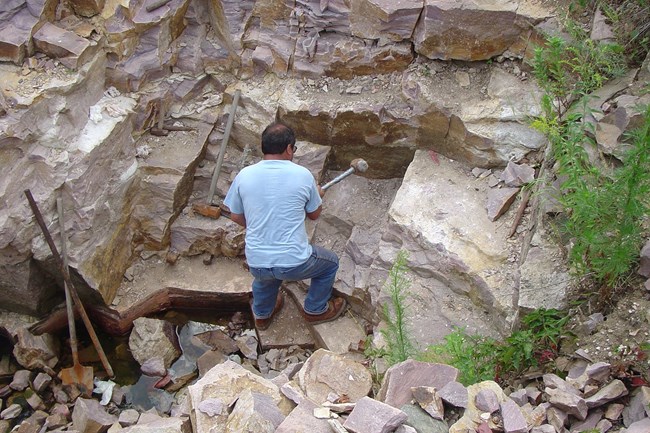Last updated: October 28, 2020
Article
Quarrying and Grit: What it Takes

NPS
Located in rural southwestern Minnesota, the pipestone quarries are considered a sacred site by many American Indians. For the last 2,000 years or more, tribes across the central region of North America have traveled to this site to quarry. Today, they still travel long distances to this site to continue the tradition of pipestone quarrying and pipe making.
Pipestone quarrying is often an underappreciated part of the tradition surrounding pipe making. The task of extracting pipestone from the earth is slow and laborious using hand tools and methods similar to those used for centuries. The process can require many days of physical labor with only sledgehammers, pry bars, chisels, and wedges. Good physical condition is a prerequisite.
Depending upon the specific quarry pit and amount of material extracted, experience has shown that quarrying time can be estimated at two to six weeks to reach the pipestone layer. This pipestone is sandwiched between layers of very hard Sioux Quartzite that is harder than granite. Depending upon a quarry’s location along the quarry line, the upper levels of quartzite can be four to ten feet thick above the pipestone layer. Prairie plants and soil varying in depth from one to six feet cover the upper layer of quartzite.
Quarriers use shovels and wheelbarrows to dig up surface soils and glacial till. Then they dump it in rubble piles at the rear of the quarries. Subsequently, broken pieces of quartzite rock are also discarded.
The upper layer of quartzite is composed of multiple quartzite strata, with vertical fractures and cracks in the rock. Wedges or chisels are placed into these cracks and can be driven down with sledge hammers to break apart individual quartzite blocks. Upon loosening a piece, it is worked free with a steel pry bar and dropped onto the floor of the quarry. Heavy sledge hammers are then used to break the bigger chunks of quartzite into smaller, more manageable pieces that can be lifted and thrown out of the back of the quarry. The process of breaking out the quartzite is repeated many times until the pipestone layer is exposed.
The smaller pieces of quartzite are also used in building a retaining wall along the front of the rubble pile. The rock wall serves as a barrier so that the growing rubble pile is prevented from collapsing back into the quarry. Building a sturdy retaining wall to keep rock and fill out of the pit is an essential part of managing a quarry and a very important protective safeguard for quarriers.
Once the pipestone is exposed, care must be taken in removing the stone as it is very fragile and can break. The pipestone layer may vary from 10 to 18 inches thick and is composed of multiple layers from 1 ½ to 3 inches thick. Individual layers are carefully removed one slab at a time by driving wedges into the natural horizontal seams. The natural vertical cracks in the quartzite carry down through the pipestone, which allows the quarrier to remove the pipestone layers in irregularly-shaped slabs. More on Geology.
The quarry pits are located in the bottom of a bowl-shaped drainage. In the spring and early summer months groundwater from rain and snow melt collects in this low lying area, filling the quarries with water. Most quarriers prefer to work during the summer to late fall months to avoid the groundwater problems. Monument staff will assist quarriers by pumping water out of the quarries, but only two days ahead of when quarrying is planned. Often, when it is high, groundwater will flow back into the quarries as fast as it is pumped out. Since continued pumping will not reduce the water level, it will not be attempted during these periods when groundwater is high.
